

Did you know that, according to a study by Membership Geeks, 88.8% of e-learning professionals believe starting a membership site was one of their best business decisions?
It’s not surprising at all.
Membership sites help you earn a passive income, give you more freedom, and allow you to grow your authority and influence by building your tribe.
But what exactly is a membership site, and how do you make money with it?
In this article, we’ll answer those questions and share a roadmap to building and growing your own information-based membership site, along with multiple membership site examples.
You can also explore the best membership site platforms on the market to help you launch and grow a thriving membership offering.
Let’s dive in.
What Is A Membership Site?
A membership site contains gated content only registered members can access. It’s an exclusive club where the members get premium training content and solutions for a fee. A membership program can be in the form of a dedicated website, a specific section of a site behind a paywall, or a members-only social media group.
Membership site owners charge customers based on the volume and value of their content and the frequency of new content updates. At the same time, members pay for the convenience of accessing top-quality resources in one place.
Memberships are among the most popular business models in the eLearning industry as they offer value to content creators and their customers. This is why you’ll find membership sites in almost any niche where people sell info products.
For example, here’s a dedicated membership program for knitting enthusiasts that offers knitting patterns, training content, and other resources.


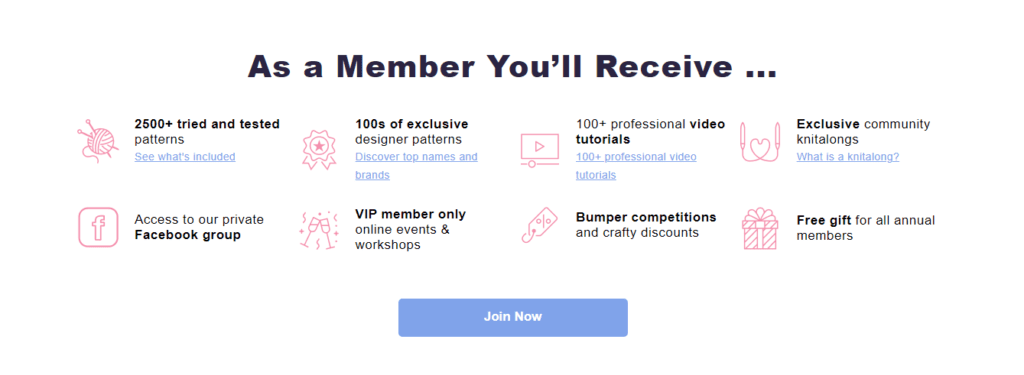

Unlike standalone digital products, membership sites often contain multiple info products, tools, templates, and direct access to leading industry experts at an affordable monthly price, making them quite attractive to customers.
On the other hand, memberships enable content creators to earn a passive income, monetize their content, increase authority, and build a community-driven eLearning business that gains value with time.
What Does A Membership Site Offer?
A membership site can offer anything from exclusive articles and content to a combination of courses, tools, templates, live training, and members-only events.
However, most membership programs in the eLearning space contain one or more of the following content types.
– eBooks and downloadable PDF content.
– Training videos and how-tos.
– Online courses
– Case studies and behind-the-scenes content.
– Live training sessions.
– Live Q&A sessions via Zoom or other live streaming solutions.
– Past video recordings
– Templates and worksheets
– A dedicated member group or community to network, exchange ideas and ask questions.
– Mastermind calls
– Members-only articles
– Podcasts
– Virtual events
– Learning tracks leading to certification
Don’t be overwhelmed by this list because few membership sites offer everything together. So, if you’re just starting, focus on offering one or two of those resources, and add new content with time. For example, start with weekly or monthly live training sessions plus a member-only Slack or Facebook group.
Why Start A Membership Site? 4 Long-Term Benefits
Growing a membership program takes time, resources, and hard work. But once you pull it off, it offers numerous immediate and long-term benefits to your business.
Easier To Sell Than High-Ticket Offers
Membership sites are usually more affordable than standalone courses and high-ticket training programs, making them attractive for customers interested in your content.
A recent survey shows over 73% of eLearning membership programs charge less than $50 per month.
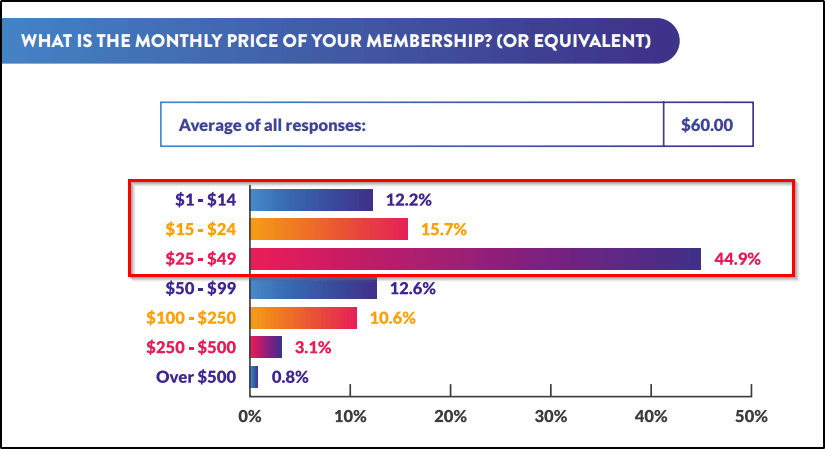

You can easily attract customers at these price points and give them a taste of your premium content, paving the path for high-ticket sales in the future.
Adds Recurring Passive Income To Your Business
A membership site is an excellent passive income source that helps diversify your business, reduce risk, and free up time. In addition, you can use it to generate a monthly recurring income that grows with your subscriber base.
For example, Bushra Azhar’s Persuasion Hacks Lab started as a small members-only Facebook group priced at $39 per month. But with time, it grew to over a thousand members, bringing in thousands of dollars every month.


You can also increase your membership price as your program grows, becomes more valuable, and attracts more customers. So, for example, if you have a group of 300 paying customers, raising your subscription fee by just $10 would increase your monthly revenue by $3000.
Grows Your Influence And Brand Authority
A membership site is among the best ways to position yourself as an authority in your niche because it’s a dedicated community of people who pay you every month to listen to your advice, consume your content, and seek your validation for their projects.
It positions you as a mentor, teacher, and consultant and opens new ways to monetize your influence. In addition, you can grow your network by interacting with your subscribers, knowing new people, and building new connections.
Increases Your Content’s ROI
A membership site allows you to drive more revenue from each piece of content, turning it into a long-term business asset. For example, instead of holding one-off live sessions only, you can add the session recordings to your member’s areas where your subscribers can access them at their convenience.
Similarly, keep adding new articles, eBooks, templates, and any other relevant resources to your membership to increase its value and offer more content to your subscribers in one place.
As your content-gated content library grows, you can organize it for easier consumption and develop learning tracks to help your members reach specific outcomes.
Types Of Membership Site Models
Your membership site’s structure depends primarily on two things.
- Its pricing model
- Its content delivery model
In one of our previous articles, we’ve discussed membership pricing models in great detail. But let me give you a quick reminder.
When pricing a membership site, you can go for:
- The freemium model in which the members can sign up with just their email addresses and access content without paying a fee
- The premium model, where the members pay a monthly, quarterly, or annual membership fee
- The hybrid model is where the members can register and access some of your content for free but must upgrade to a premium subscription for specific resources.
But let’s talk about the different content delivery models you can use with these pricing strategies.
The Drip Content Model
In the drip content model, subscribers don’t get access to all the premium content at once. Instead, you deliver content in batches by unlocking new modules every month or when a subscriber completes a prerequisite. This is a popular model for membership sites that offer modular online courses and workshops.
For example, 10x Freelancer, a premium subscription program by CopyHackers, follows the drip content model.
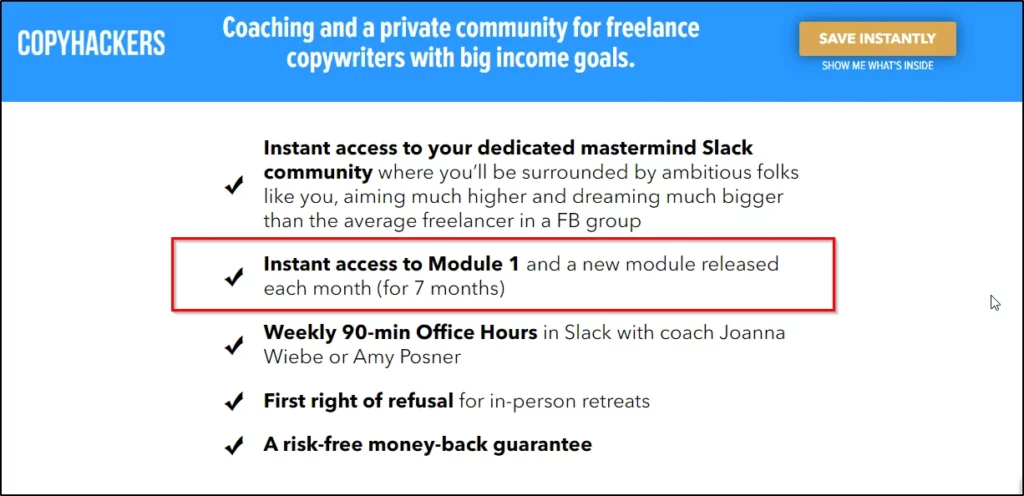

It’s a grand course spread over eight modules, unlocked one by one every month. The members can only access the modules they’ve qualified for, which means they need to stay subscribed for at least eight months to access the entire course.
This model is perfect for long and complex online courses, allowing members to consume each lesson before moving on to the next one. Plus, it helps you increase your average customer lifetime value by keeping them subscribed till they can access all the content.
However, it only works when you have enough content to serve your members. But if you don’t have much content, the following model might suit you better.
The Continual Content Model
In the continual content model, you start your subscription program with limited content but add new stuff regularly. The anticipation for new content keeps your subscribers loyal to your program while giving you the space to build your content library as you go.
This model is ideal when your content is not yet in the form of a proper online course but is still valuable to your audience. It’s also a suitable model for evergreen niches with constant demand for new content.
For example, here’s a membership program that delivers a new recipe eBook to its members every month.


According to its landing page, this program is priced at $12.5 per month and has over 1100 members. That’s almost $14K per month just from sending recipe eBooks. That’s the power of growing a loyal subscriber base.
News websites offering new members-only content are also a prime example of the continual subscription model.
The All-Access Model
The all-access model allows members to dive straight into its content archives without any limits. As soon as members join the program, they get access to all the premium content without delays. This contrasts the drip model, where the content is released periodically.
Digital Marketer Lab is a classic example of this subscription model.
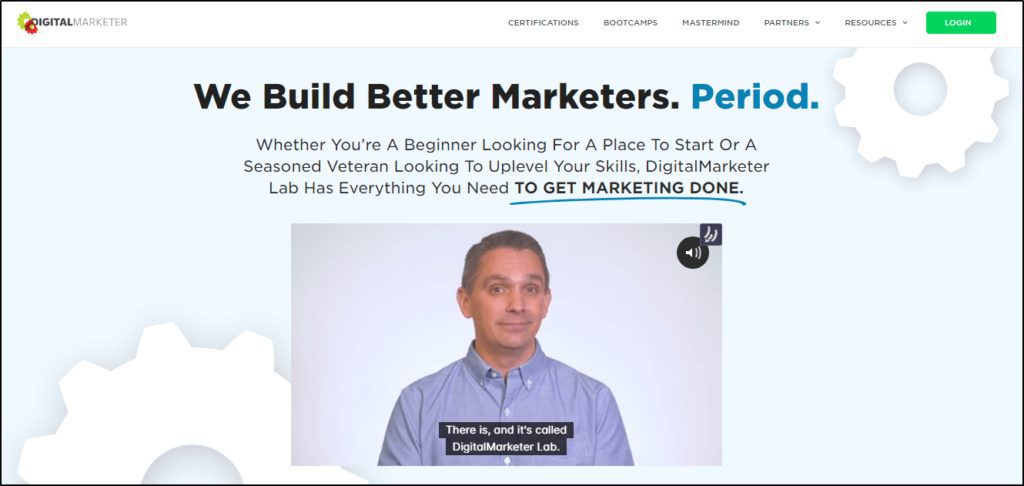

It gives members instant access to dozens of courses, certification programs, event recordings, and a vibrant online community of digital marketers.
Membership sites following this model have a perceived value and easily attract members based on the content volume. However, subscribers can struggle to fully benefit from such programs because too much content is often overwhelming.
The Community Model
Sometimes all you need to attract subscribers is a valuable online community where they can interact with experts, pick their brains when they want, and freely exchange ideas.
This is why most subscription plans offering online courses and other resources include dedicated community access to their plans.
But if you’ve built a high-profile community, you can offer it as a standalone subscription program because people value access to experts.
Traffic Think Tank, a million-dollar online community, is an excellent example of this model.


It’s a group of seasoned SEO professionals from companies like HubSpot, Shopify, Moz, and Google where marketers can exchange ideas, discuss strategies, collaborate, and network.
It started as a simple discussion group but later evolved into a full-scale Slack community with hundreds of members and a dedicated library of exclusive SEO content.
The Fix-Term Model
The fix-term model is a time-sensitive membership that expires after a specific duration. Unlike memberships that keep you subscribed as long as you pay, fixed-term memberships force members to take action and consume content within the limited membership duration.
The 90-Day Content Challenge is an example of this model.


Thought Capital’s 90-day program for CEOs and entrepreneurs is another great example.


Both these programs offer resources and mentorship along with assignments and targets members need to meet within 90 days.
Use this model if you have a practical roadmap for your members or if you believe you have time-sensitive information that members need to implement asap.
How To Build A Membership Site From Scratch
Building a membership site isn’t as complex as it used to be, thanks to the numerous tools, plugins, and platforms designed specifically for membership programs.
So, when starting a membership site, you can choose one of the following approaches.
Build A WordPress Membership Site
WordPress is the world’s most popular CMS for a reason. You can use it to create any kind of website, including memberships and gated content.
Here are the best WordPress plugins that will allow you to set up fully functional membership sites.
MemberPress
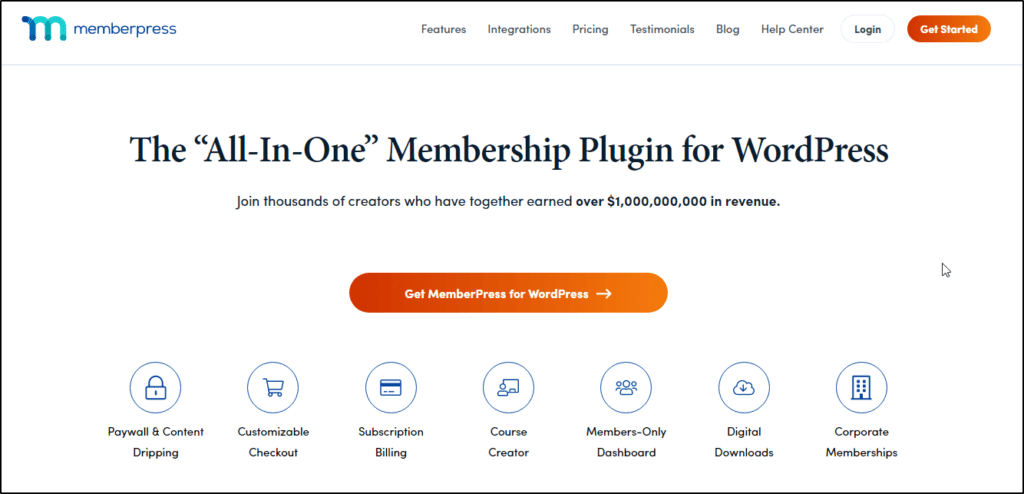

One of the best WordPress membership plugins that allows you to create different membership tiers, offer drip content, sell online courses, and use many other eLearning features to create a memorable membership experience.
Read our detailed MemberPress review for its features, pricing, use cases, and examples.
MemberSpace


MemberSpace is a multipurpose WordPress membership plugin with all the core features you need to set up various types of membership sites.
Read our detailed MemberSpace review to learn more about it.
LearnDash


LearnDash is a top-rated WordPress learning management plugin that allows you to create membership programs, online courses, and engaging communities.
Read our detailed LearnDash review to learn more about it.
LifterLMS
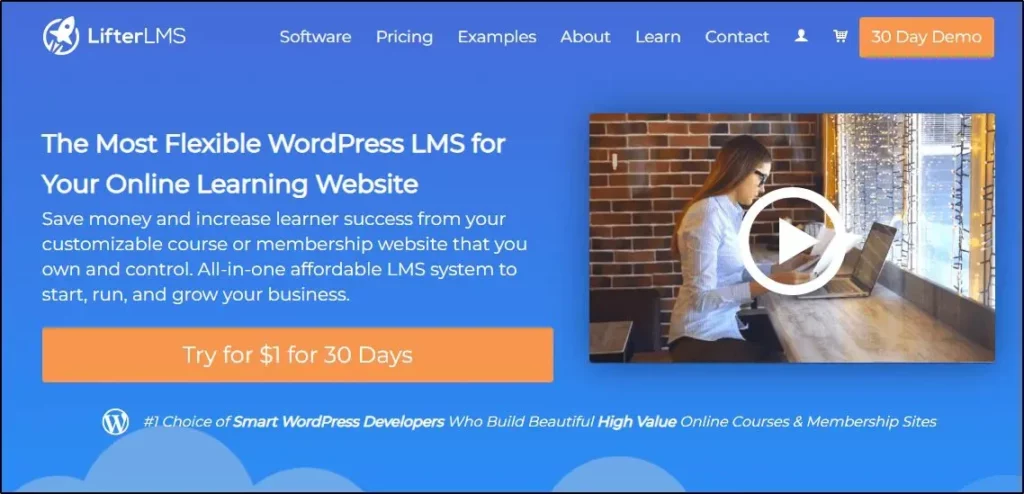

LifterLMS is among the most robust eLearning WordPress plugins with world-class membership and subscription features.
Read our LifterLMS review to learn more about it.
Use A Membership Platform
To avoid the hassle of setting up a WordPress membership site, you can use any of the following membership platforms explicitly designed for non-technical users.
Kajabi
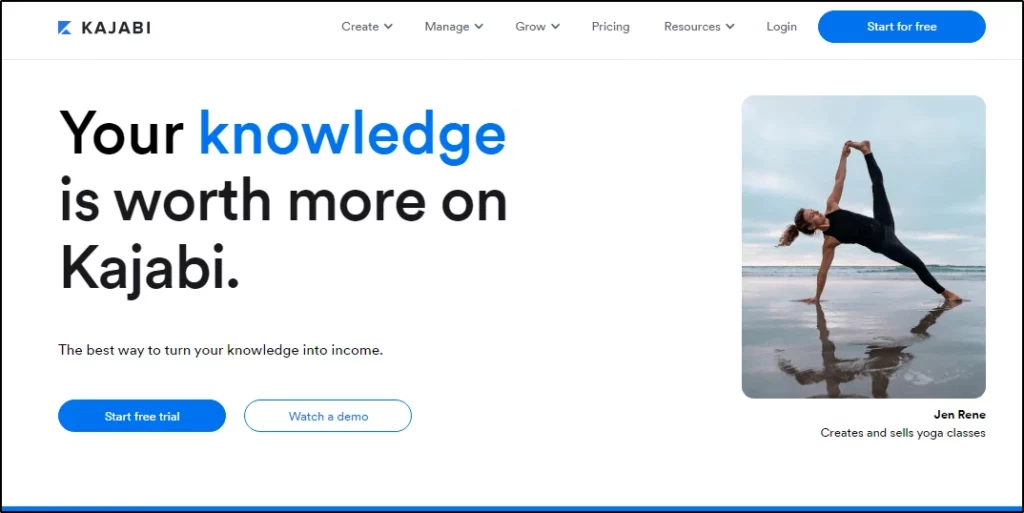

Kajabi is among the best online course and membership site platforms globally. It’s a one-stop solution offering everything from landing pages, membership tiers, drip content to quizzes, community-building tools, and email marketing features.
Read our detailed Kajabi review to learn more about it.
Thinkific


If you’re looking for a user-friendly membership platform that offers world-class subscription and online course creation tools, Thinkific is an excellent choice.
Read our detailed Thinkific review to learn more about it.
Podia
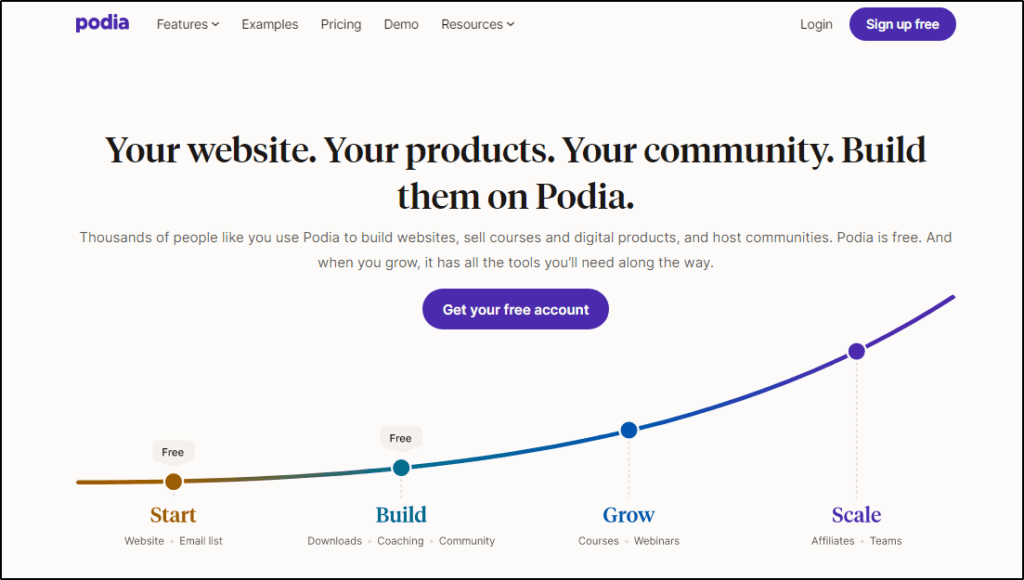

Podia offers excellent value for money and allows you to easily create, manage, and grow your membership business.
Read our detailed Podia review to learn more.
11 Tips For Growing A Profitable Membership Site
Thanks to modern membership tools and platforms, starting a membership site is pretty straightforward. However, growing a profitable membership business requires consistency, patience, and a well thought out strategy.
Here are a few tips to help you succeed.
1. Offer Immense Value
You can’t grow a successful membership program without blowing away your members with valuable content. The more value you offer, the faster your subscriber base grows.
But how do you define value? What does providing value even mean?
It means that you answer the questions, solve the problems, and simplify the challenges of your customers. In other words, give them what they came for, make their lives easier, and help them achieve the transformation they’re looking for.
Every piece of content you create, every session you host, or every template you upload should solve a problem and help your members move forward.
The more consistently you do that, the longer your members stay.
So, before starting a membership program, ask yourself what you want your program to be known for. How do people remember it?
Is it just going to be another collection of helpful resources? Or a transformational community that helps your members 10x their results?
Aim for the latter, and no one will ever question your membership’s worth.
2. Attract Members With $1 Trials
You don’t want freebie hunters in your group because no matter what you do, they won’t buy. So, to attract genuine customers and people ready to spend money on the right information, offer $1 trials of your group memberships.
College Success Formula, a membership site for college students, uses this method to drive sales.
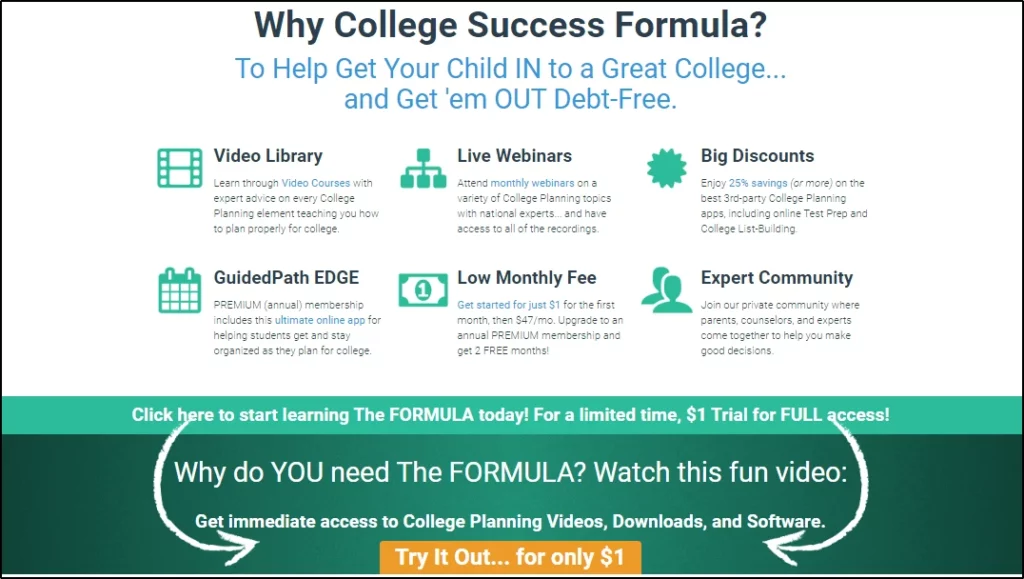

You can limit the trial to a week or a month, depending on the frequency of activity in your group. Once the trial period ends, the user is automatically charged and upgraded to full member status unless they opt out of it in time.
But if your content is the right fit for a trial user, they’re more likely to upgrade to full membership because they’ve already trusted you with their payment information.
3. Focus On Maximizing Customer Lifetime Value
Don’t be greedy in pricing your membership program because, in this business model, growth comes from maximizing customer lifetime value, not one-time sales.
Set an entry-level price that your members can pay every month without breaking the bank or questioning their membership ROI every month.
You can then increase your customer lifetime value in two ways.
- Retain members longer
- Drive more revenue with special events, members-only discount offers, and upsells.
The longer a member stays with you, the likelier they will purchase your add-ons and upsells and refer new members to your program.
So, think long-term and strike the right balance between profitability and convenience when pricing your membership.
4. Introduce A Founding Member Price
Introducing a founding member price is an excellent way to encourage quick sign-ups to a new membership program.
For example, you could introduce a regular price of $47/month for your membership program but offer it at a 70% discount for the first ten members, 60% for the next ten, and reduce the discount till you get the first 100 members.
The founding member tag incentivizes people to join early and attracts them with the associated discounts.
5. Introduce Membership Tiers
If you have enough content, consider offering multiple membership tiers. For example, you could have Silver, Gold, and Platinum memberships with different perks. But to make each tier unique, offer something drastically more valuable in each higher-priced plan.
This could be in the form of events and training for specific tiers, more personalized time, access to priority groups, or any other valuable incentive on top of your core membership offer.
6. Add A Slack Group To Your Membership Site
Irrespective of your membership site’s content delivery model, adding a dedicated members-only Slack group or community to the package makes it significantly more valuable.
Giving members the ability to interact, network, and share ideas adds a separate layer of value over your core membership[ program. So even when members don’t fully benefit from your core offer, the value they drive from your online community keeps them subscribed to your program.
7. Engage Members With Live Q&A Sessions
Delivering weekly, fortnightly, or monthly live Q&A sessions for your members is a proven way to retain members longer and keep them engaged with your course content.
If you’re camera-shy or short on time, you can replace live video sessions with live chat Ask Me Anything (AMA) sessions where the members can drop their questions, and you can answer them whenever you get time.
For example, Joanna Wiebe, the founder of Copy School, holds “office hours” every week, where she answers the questions the members of her exclusive Slack community ask throughout the week.
It’s an excellent way to provide value to your members and help them make real progress.
8. Market Your Member Success Stories
As your members benefit from your content, make sure you tell the world about their success. This social proof is vital to your program’s growth and brand image.
To keep new success stories coming up, regularly ask members to share their weekly or monthly wins. Ask them to share how your content has helped them and share their story to market your program.
9. Give Prospects A Sneak Peek Into Member Activity
Trigger FOMO in non-members by sharing screenshots of anything valuable inside your membership program.
For example, if you hold a members-only live training, share screenshots on Twitter, Facebook, LinkedIn, and any other social networks your audience uses.
Show them the stuff that happens inside your membership, create anticipation, and make them regret their decision not to sign up for your program.
10. Open Memberships Once A Year
If you want people to value your membership program and accept any price point without blinking an eye, open it for a short period of time every year.
Make it an exclusive, time-sensitive membership program that only the people on your waiting list can join.
Once the membership window closes, use your program’s landing page to grow your waiting list. Keeping people waiting to join a program makes them want it more. Use this tendency to your advantage.
11. Recruit Affiliates To Attract New Members
If you’ve been running your membership program for a while and have loyal members who’ve benefited from your content, consider making them your affiliates.
Affiliates earn a commission for every sale they drive. But in return, they promote your program, spread the word about it in their circles of influence, and share their own success stories to persuade new members.
This has a far greater impact on your direct marketing tactics.
Are You Ready To Make Money With A Membership Site?
Consider this article a crash course in starting a membership site. Now, it’s time to implement and take action. Whether you’re a seasoned eLearning professional or a beginner, there’s no entry barrier to starting a membership program. If you’re passionate about a topic, you probably already know more about it than most people. So, instead of doubting yourself, quickly set up a membership program and start growing your subscriber base.
Let me know if you have any questions.
Table of Contents










